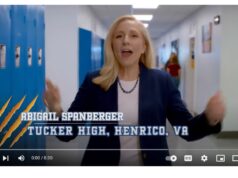There’s been a lot of discussion recently about this story:
A group of Arlington high school students lambasted the county school board Thursday over a plan to shift the boundary lines for the district’s three high schools, saying that it fails to address concerns about economic segregation in the wealthy D.C. suburb.
For those interested in reading the original opinion piece, written by a student at Washington-Lee High School, click here. In turn, that opinion piece was responding to the December 1 decision by the Arlington County School Board, which “approved high school boundary refinements to balance enrollment and space utilization among the three APS comprehensive high schools by the 2020-21 school year.”
At the December 1 Arlington County School Board meeting, the Board voted unanimously (5-0) in favor of “Boundary Refinement Option 4,” to “provide better enrollment balance and space utilization among the three [Arlington Public Schools] comprehensive high schools by the 2020-21 school year.” See School Board member Barbara Kanninen’s explanation, below, regarding why she – and ultimately, the entire School Board – voted to support Option 4. Key point by Kanninen on diversity, which is the center of the controversy over this decision: “this is something we all care about…however, the limitations we put up front on this process – the high schools are where they are, the boundaries are where they are…we limited this process to a refinement, and at the end of the day, the options we have in front of us are neutral in terms of the diversity issue.”
As far as I can determine, the unanimous Arlington County School Board got this one largely right, within the limits of what the School Board can actually do of course. The broader point, in my view, is that public schools reflect their communities, and if the communities are segregated by economics, race, or anything else — and sadly, the country as a whole has become, if anything, MORE segregated over the past few decades, as people have moved to communities where people are “just like them — then the public schools will be too. Thus, even in a compact county like Arlington, the high school (Wakefield) in highly diverse South Arlington is around 80% non-white, while the high school (Yorktown) in wealthy/white far-north Arlington is 65% white and just 6% African American. Last but not least, the high school (Washington-Lee) in the “middle” of Arlington is highly diverse — 41.2% white, 34.1% Hispanic, 10.4% Asian-American, 9.0 African American and 5.1% multiracial. The question is how much a School Board – any School Board, really – can do to even this distribution out, given the desire of students and their families to be near their schools, with their friends/communities, not stuck with a lengthy commute to and from school, etc, etc.
It’s also worth nothing that all three Arlington High Schools are excellent, by all accounts. Another point is that students at Wakefield can, if they want, transfer to Yorktown (and vice versa) — but few do so.
Finally, I’d point out that Arlington County is becoming less and less diverse as the years go by, in large part due to lack of housing that’s affordable for all income levels. That, in turn, is a direct result of policy choices made by Arlington County’s Board, specifically with regard to things like housing density, zoning, public transportation, etc. Given current policies, housing supply in Arlington County is de facto constrained/very slow growing, yet demand is high for housing at all income levels in Arlington, and the population of the greater D.C. metro area keeps growing. Which means – as anyone who has studied Econ 101 knows – that the price of housing has kept rising in Arlington, further pricing out poor, working-class, and even middle-class people (and, as an added “bonus,” encouraging sprawl, as people in the region looking for housing rule out places “close in” like Arlington and instead “sprawl out” to Loudoun, Prince William, etc.). The broader question for Arlington County is whether people are content to see these trends continue or are willing to take strong actions to turn them around.
For now, though, Arlington remains both: 1) segregated by income, ethnicity and race; and 2) increasingly too expensive for anyone but fairly high-income people to live in. Given that situation, again, I’m not sure exactly what the School Board is supposed to do, but clearly their (unanimous) decision of December 1 has stirred up some passionate opposition. See below for examples of that, from the December 15 School Board meeting, followed by responses from all five School Board members (James Lander, Emma Violand-Sanchez, Nancy Van Doren, Barbara Kanninen, Reid Goldstein). As Van Doren explains, the primary objective of this exercise was to relieve overcrowding at Washington-Lee High School. In doing so, all six criteria (efficiency, proximity, stability, alignment, demographics, and contiguity) were considered. Only about 85 students per year will be moved over the next four years — less than 5% of Arlington’s High School population. Finally, the percentage of “free-and-reduced-lunch” students “will change no more than 1% for each school over the next four years.”
With that, check out the videos below and on the Arlington Public Schools website, and feel free to leave your thoughts in the comments section. Thanks.
December 15 Arlington County School Board meeting


 Sign up for the Blue Virginia breaking news newsletter
Sign up for the Blue Virginia breaking news newsletter











